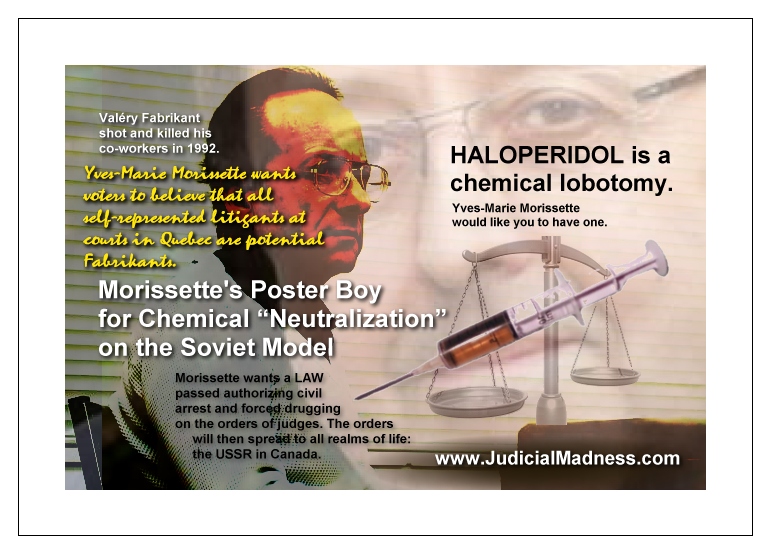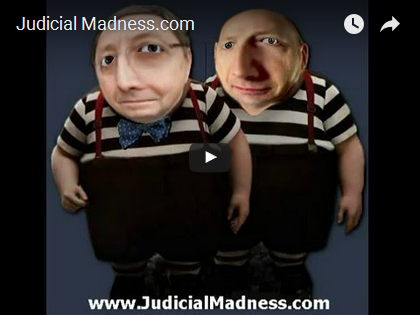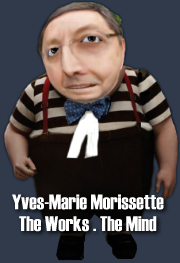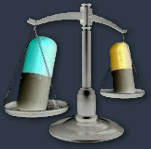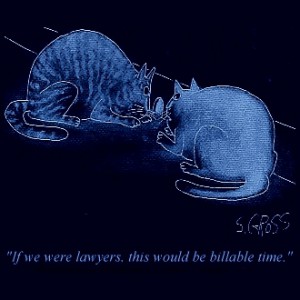Se Représenter Seul
Without A Lawyer
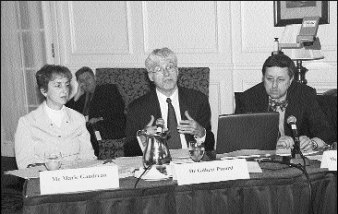
De gauche à droite (From left to right) :
Maître Marie Gaudreau, Dr. Gilbert Pinard, Maître Yves-Marie Morissette.
The phenomenon of the self-represented litigant, the problematic of the too-quarrelsome litigant, and querulousness, were the subjects broached by the lecturers.
Se Représenter Seul
Without A Lawyer
This featured item is an exclusive English translation of an article in French by Claude Duchesnay, a lawyer who writes for the Quebec Bar Review. The original French article appeared under the title, “Se représenter seul” in Volume 34, Number 13 of the Quebec Bar Review on August 1st, 2002. Any flaws in the English translation are entirely our fault; Mr. Duchesnay and the Quebec Bar Association have nothing to do with it. Feel free to suggest corrections, thank you.
|
Par Claude Duchesnay, avocat |
By Claude Duchesnay, lawyer |
|
Journal du Barreau |
Journal du Barreau |
|
Hors de la cour point de salut! Le phénomène de plus en plus courant du justiciable qui se représente seul, la problématique du plaideur trop belliqueux et surtout le déséquilibre de la quérulence ont fait l’objet d’un atelier intéressant et surprenant. Le panel ayant abordé ces questions était animé par Me Jean Saint-Onge et composé de la juge en chef de la Cour supérieure, Lyse Lemieux, de Me Yves-Marie Morissette, Me Marie Gaudreau et Me Hélène Morin et du Dr Gilbert Pinard. Ils ont également discuté des principaux remèdes dont disposent les tribunaux pour prévenir certains abus. |
Outside the Court, there is no salvation! The increasing phenomenon of the self-represented litigant, the problem of the overly quarrelsome litigant and in particular the imbalance of querulence were the subject of an interesting and surprising workshop. The panel that tackled these questions was led by Maître Jean Saint-Onge and composed of the Chief Justice of Quebec Superior Court, Lyse Lemieux, of Maître Yves-Marie Morissette, Maître Marie Gaudreau and Maître Hélène Morin and Dr. Gilbert Pinard. They also discussed the principal remedies available to the courts to prevent certain abuses. |
|
La quérulence |
Querulence |
|
« La quérulence est avant tout un trouble de l’affect et non de l’intellect », précise d’entrée de jeu Me Morissette. La quérulence, c’est la tendance pathologique à rechercher la querelle et à revendiquer, d’un rapport hors de proportion avec la cause, la réparation d’un préjudice subi, réel ou imaginaire. Le terme provient du latin querela qui signifie « plainte ». |
“Querulence is above all a disorder of affect and not of the intellect”, stipulates Maître Morissette at the outset. Querulence is the pathological tendency to seek quarrels and to claim reparation for alleged harm suffered – whether real or imaginary – out of proportion to the case. The term comes from the Latin, querela, which means “complaint”. |
|
Des études révèlent que les quérulents sont souvent des scientifiques, des anciens membres de professions libérales ou encore des gens qui ont connu un certain succès dans les affaires. « C’est un désordre de l’âge mur qui met un certain temps à se développer. Il est habituellement déclenché par un revers dans la vie personnelle, familiale ou professionnelle d’un individu vécu comme une injustice cuisante », ajoute Me Morissette. Ce revers débouchera sur des comportements irrationnels très ciblés dans le contexte de recours devant les tribunaux. Quatre fois sur cinq, le quérulent est un homme. Parfois, ce sera même un avocat! |
Studies reveal that querulents are often scientists, former members of the liberal professions or yet again, people who had achieved a certain success in business. “It is a disorder of mature age which requires time to develop. It is usually triggered by a reversal in the personal, family or professional life of an individual, experienced as a stinging injustice”, adds Maître Morissette. This reversal leads to highly targeted irrational behaviors in the context of recourse before the courts. Four times out of five, the querulent is a man. Sometimes, it is even a lawyer! |
|
Signes avant-coureurs |
Harbingers |
|
« Certains symptômes révèlent la quérulence, dont l’opiniâtreté et le narcissisme du plaideur », remarquent Me Morissette et le Dr Pinard. La multiplication des recours vexatoires, y compris contre les auxiliaires de justice, l’inventivité et l’incongruité des recours successifs qui vont en s’amplifiant et reprennent toujours les mêmes questions, l’incapacité de payer les dépens et les appels incessants, témoignent également tous de la personnalité quérulente. |
“Certain symptoms reveal the querulence, including obstinacy and the narcissism of the litigant”, commented Maître Morissette and Dr. Pinard. The multiplication of vexatious recourses, including against the auxiliaries of justice, the inventiveness and the incongruity of successive recourses which always amplify and develop the same questions, the inability to pay costs and the incessant appeals, also all bear witness to the querulous personality. |
|
La quérulence est-elle un problème de la psychiatrie ou du système judiciaire? « Règle générale, le quérulent est une personne qui peut vivre normalement en société, constate Yves-Marie Morissette. Quoique certaines médications peuvent être prescrites, c’est avant tout une personne qui a trouvé son divan, et c’est le tribunal! » |
Is querulence a problem of psychiatry or of the justice system? “As a general rule, the querulent is a person who can live normally in society, ” notes Yves-Marie Morissette. “Although certain medications can be prescribed, this is above all a person who has found his couch, and that is the court!” |
|
Autorisation préalable nécessaire |
Prior authorization necessary |
|
Quels sont les remèdes à la quérulence? Me Yves-Marie Morissette a dressé un bilan des pistes de solutions dégagées par la jurisprudence. Au premier rang, se trouve l’importante décision de la Cour supérieure dans York c. Paskell Mede. Dans cette affaire, un quérulent exerçait des recours incessants contre son ex-avocate. La Cour supérieure a assujetti le poursuivant à l’autorisation préalable de la juge en chef, ou de tout autre juge désigné par elle, pour intenter toute poursuite, non seulement contre le défendeur mais également contre quelque personne que ce soit. Cette décision n’a bien sûr d’effet que dans le cadre de la juridiction de la Cour supérieure. |
What are the remedies for querulence? Maître Yves-Marie Morissette drew up a list of the solutions advanced by the jurisprudence. In the forefront is the major decision of Quebec Superior Court in York c. Paskell Mede. In this case, a querulent exerted endless recourses against his former lawyer. Superior Court subjected the litigant to the prior approval of the Chief Justice, or any other judge designated by the latter, in order to institute any proceeding, not only against the defendant but against anyone at all. This decision of course has no effect except within the framework of the jurisdiction of the Superior Court. |
|
Dans une autre affaire récente, l’affaire Choueke, la Cour a de plus condamné le demandeur à des dépens additionnels. « Le cas le plus connu en droit québécois, c’est très certainement l’affaire Fabrîkant », poursuit Yves-Marie Morissette. Il y avait une quarantaine de dossiers Fabrikant, lorsqu’au mois de mai 2000 le juge François Rolland, de la Cour supérieure, a imposé à M. Fabrikant le même type de contrainte que dans l’affaire York. |
In another recent matter, the case of Choueke, the Court moreover condemned the applicant to additional costs. “The best known case in Quebec law is undoubtedly the Fabrîkant affair”, continues Yves-Marie Morissette. There were some forty Fabrikant files, when in the month of May 2000, judge François Roland of Superior Court, imposed on Mr. Fabrikant the same type of constraint as in the York case. |
|
Une liste des quérulents |
A list of the querulents |
|
Il existe d’ailleurs dans l’Intranet du ministère de la Justice du Québec une liste à jour des personnes qui nécessitent une autorisation préalable à l’exercice de recours judiciaires devant la Cour supérieure et le Tribunal de la jeunesse. Sur cette liste, bien qu’incomplète, apparaissent 53 noms. La Cour du Québec exerce aussi ce droit à l’occasion. Le phénomène de la quérulence fait aujourd’hui l’objet d’études dans plusieurs pays occidentaux. |
There moreover exists in the Intranet of the Quebec Ministry of Justice an up-to-date list of those persons who require prior authorization to exercise legal recourses before Quebec Superior Court and the Youth Court. On this list, although incomplete, 53 names appear. The Court of Quebec also exercizes also this right on occasion. The phenomenon of querulence is today the subject of studies in several Western countries. |
|
Une situation délicate |
A delicate situation |
|
Le justiciable qui se représente seul est un phénomène de plus en plus courant. C’est en matière familiale que l’on observe le mieux l’ampleur du phénomène. Devant la Chambre de la famille de la Cour supérieure, le pourcentage des affaires où une partie n’est pas représentée est passé, entre 1994 et 1999, de 30,3 % à 43 %. À l’inverse, devant la Chambre civile, le pourcentage a légèrement diminué durant la même période, passant de 16,2 % à 14,2 %. En Chambre civile de la Cour du Québec, le nombre de justiciables non-représentés a également diminué de 27,5 % à 20,3 %. |
The self-represented litigant is an increasingly current phenomenon. In family matters, one can best observe the intensity of the phenomenon. Before the Family Division of Quebec Superior court, the percentage of files where a party is not represented passed from 30.3% to 43% between 1994 and 1999. Inversely, before the Civil division, the percentage diminished slightly during the same period, passing from 16.2% to 14.2%. In the Civil division of the Court of Quebec, the number of non-represented litigants has also decreased, from 27.5% to 20.3%. |
|
Les causes invoquées pour se représenter seul sont principalement le coût de la justice, la baisse de confiance envers les membres du Barreau, la volonté d’accès à la justice et le faible plafond d’admissibilité à l’aide juridique. Me Marie Gaudreau remarque que l’absence de représentation de la partie adverse rend délicat le travail de l’avocat. De plus, elle craint que l’absence de représentation par un professionnel du droit nuise à la qualité de la conduite du dossier du justiciable. |
The reasons advanced for appearing alone are mainly the cost of justice, a decline in confidence toward members of the Bar, a desire for access to justice, and the high ceiling for entitlement to legal aid. Maître Marie Gaudreau remarks that the absence of representation for the adverse party makes the lawyer’s work a delicate task. In addition, she fears that the absence of representation by a legal professional damages the quality of the conduct of the litigant’s file. |
|
« En Chambre criminelle, il ne faut pas que le procès ne devienne une parodie de justice », met en garde Me Hélène Morin. L’avocate constate qu’en matière pénale le phénomène de la quérulence se retrouve plus souvent dans des situations d’agressions sexuelles et de voies de faits et entraîne le problème du contre-interrogatoire des victimes. |
“In the Criminal division, a trial must not become a parody of jsutice”, warns Maître Hélène Morin. The lawyer notes that in penal matters, the phenomenon of querulence is more often found in situations of sexual assault and assault and battery and involves the problem of cross-examination of the victims. |
|
Dans tous les cas, estime la juge en chef Lyse Lemieux, équilibre, patience, tact et courtoisie doivent guider le juge dans la conduite des procédures. « Le juge n’est pas l’avocat de la partie non représentée, mais il doit l’assister dans la compréhension de la procédure et ce n’est pas toujours facile. Le fait d’être non-représenté ne dispense pas de l’application de la règle de droit », de conclure Mme Lemieux. |
In all cases, estimates Chief Justice Lyse Lemieux, balance, patience, tact and courtesy must guide the judge in the control of the procedures. “ The judge is not the lawyer of the non-represented party, but he must assist him in understanding procedure and it is not always easy. The fact of being non-represented does not exempt an application from the rule of law ”, concludew Mme Lemieux. |
